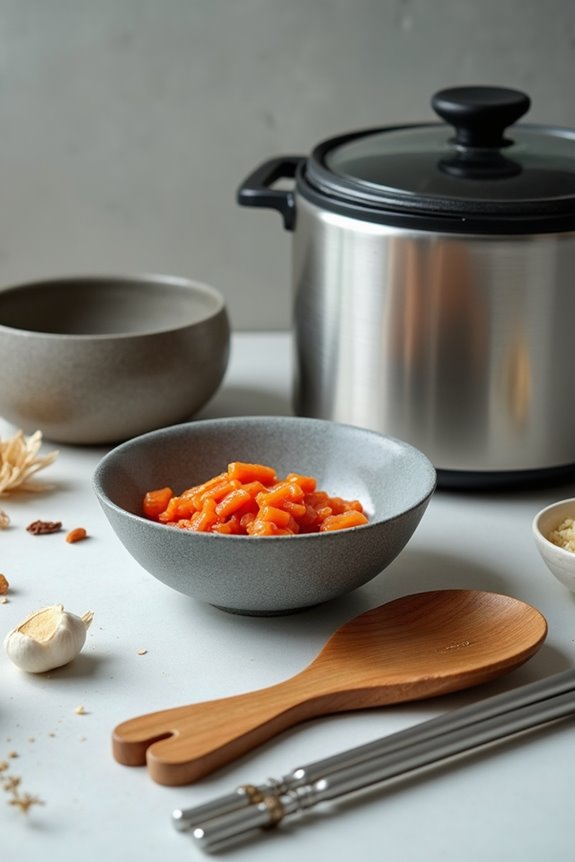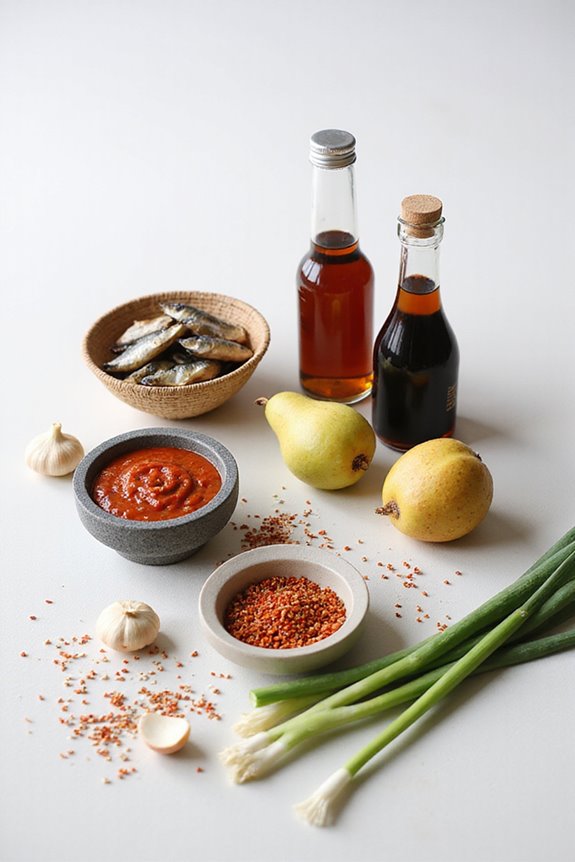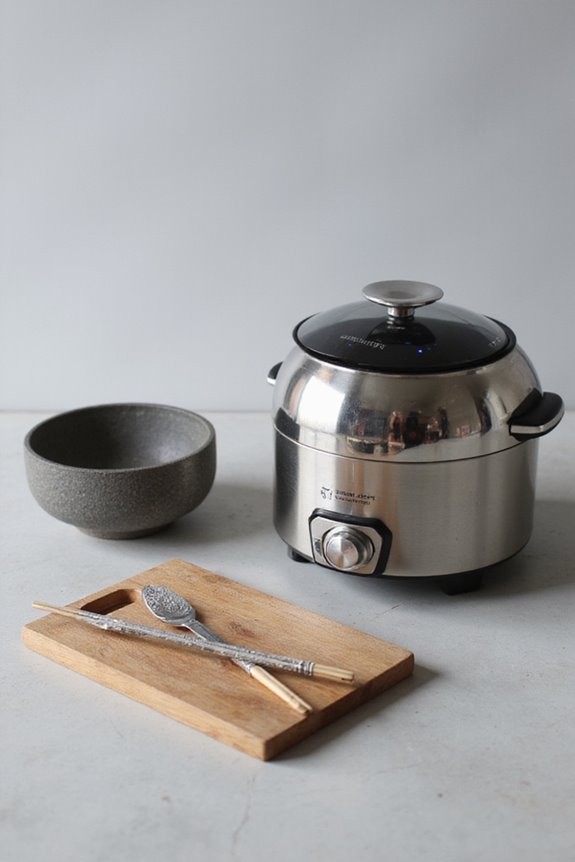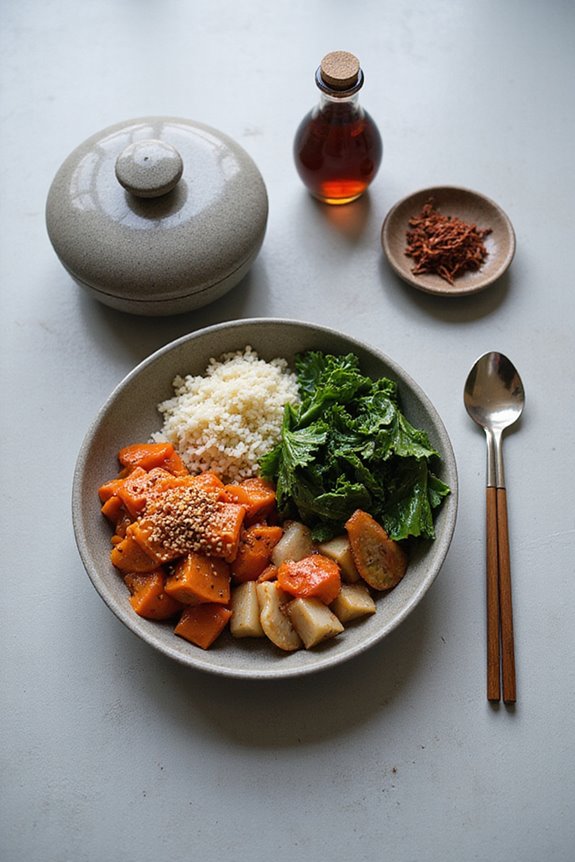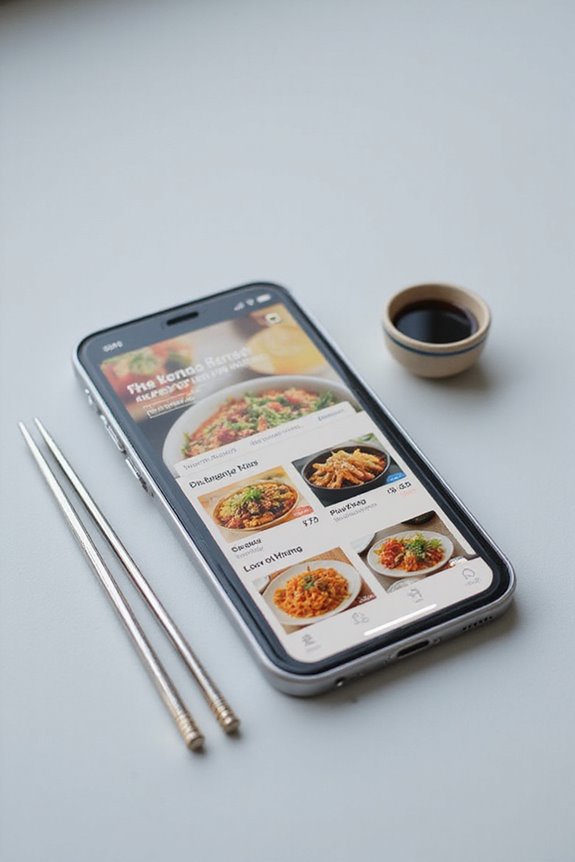In our Korean cooking, essential kitchen items enhance flavor and efficiency. Key ingredients include fermented pastes like doenjang and gochujang, which add depth to dishes. Cooking tools such as ttukbaegi improve heat retention, while a mandoline slicer guarantees uniform vegetable slicing. We also use traditional utensils like spoons and chopsticks for serving. Effective storage solutions, including airtight containers for fermented items, maintain ingredient quality. Exploring these categories further reveals additional insights into Korean culinary essentials.
Key Takeaways
- Essential fermented staples like doenjang and gochujang provide umami and depth in various Korean dishes.
- A ttukbaegi pot is perfect for retaining heat in soups and stews, enhancing flavor.
- A mandoline slicer allows for uniform slicing of vegetables, crucial for preparing banchan side dishes.
- Traditional serving utensils like spoons, chopsticks, and tongs are vital for enjoying Korean meals properly.
- Efficient storage solutions, such as airtight containers, help preserve the quality of fermented ingredients and spices.
Key Ingredients for Korean Cooking
When we explore Korean cooking, it’s essential to recognize the foundational ingredients that shape its distinctive flavors and textures. Key elements include fermented staples like doejang, which enriches soups and marinades, and ganjang, the salty soy sauce important to most savory dishes. Kimchi fermentation plays a significant role in preserving vegetables, particularly Napa cabbage and radish, along with garlic and jeot, enhancing depth and complexity. Another crucial ingredient is gochugaru, available in various types; these chili flakes infuse kimchi and countless dishes with heat and flavor. Other staples like sesame oil, garlic, and green onions further elevate dishes, making them balanced and aromatic, ensuring that these ingredients are integral to authentic Korean cuisine. Additionally, using authentic ingredients like gochujang and doenjang can greatly enhance the overall taste profile of your meals.
Essential Sauces and Pastes
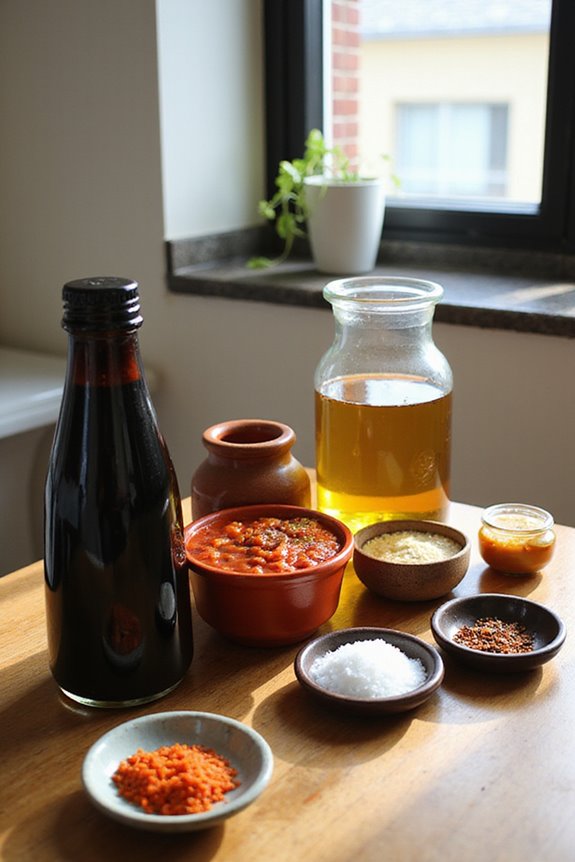
Having established the importance of foundational ingredients in Korean cuisine, we now turn our attention to the sauces and pastes that play pivotal roles in defining the flavor profiles of many dishes. Gochujang, a fermented red pepper paste, is essential for dishes like bibimbap and tteokbokki, and comes in various sauce variations based on spice levels. Doenjang, a fermented soybean paste, enhances the umami in soups and stews, while ssamjang serves as a spicy dipping sauce for Korean BBQ. Chunjang, primarily used in Jajangmyeon, adds depth and requires further cooking to reduce bitterness. Combining these pastes creates unique flavor combinations, enriching our culinary experiences and allowing us to explore the vast spectrum of Korean flavors. Additionally, using authentic ingredients ensures that the dishes maintain their traditional taste and nutritional benefits.
Cooking Tools and Equipment
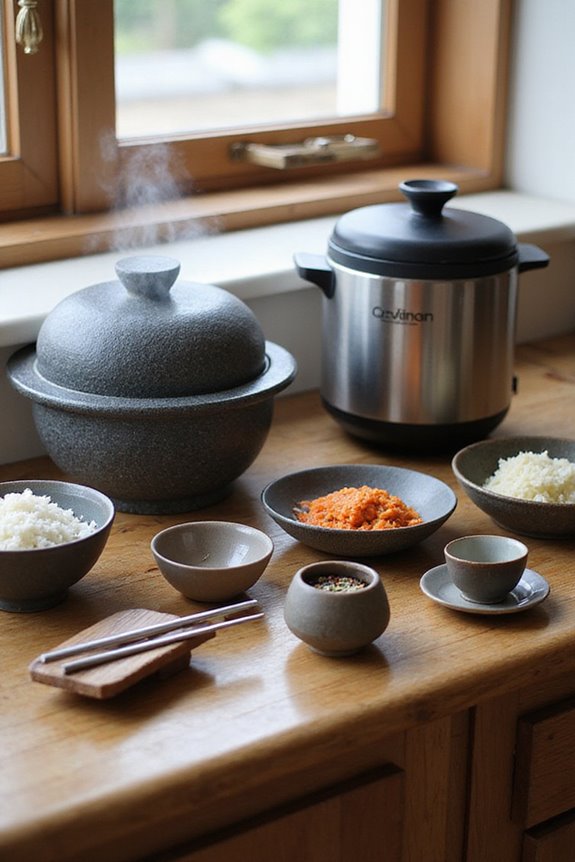
In Korean cooking, having the right tools and equipment can greatly enhance our culinary experiences while ensuring efficiency and precision in meal preparation. Essential items like a ttukbaegi for stews, or a cast iron pot for braising, greatly improve heat retention and food flavor. Additionally, a mandoline slicer allows uniform slicing of vegetables, which is vital for banchan preparation. Our kitchen organization benefits from practical utensils, like kitchen scissors for cutting materials during cooking, and electric rice cookers, which deliver perfectly cooked rice consistently. Investing in quality cooking tools helps streamline processes, improving our cooking efficiency and overall enjoyment. By maintaining well-organized equipment, we can better focus on creating delicious, authentic Korean meals. Moreover, incorporating nonstick Korean cooking pans can further enhance cooking experiences by ensuring easy food release and cleanup.
Traditional Korean Dishes Ingredients
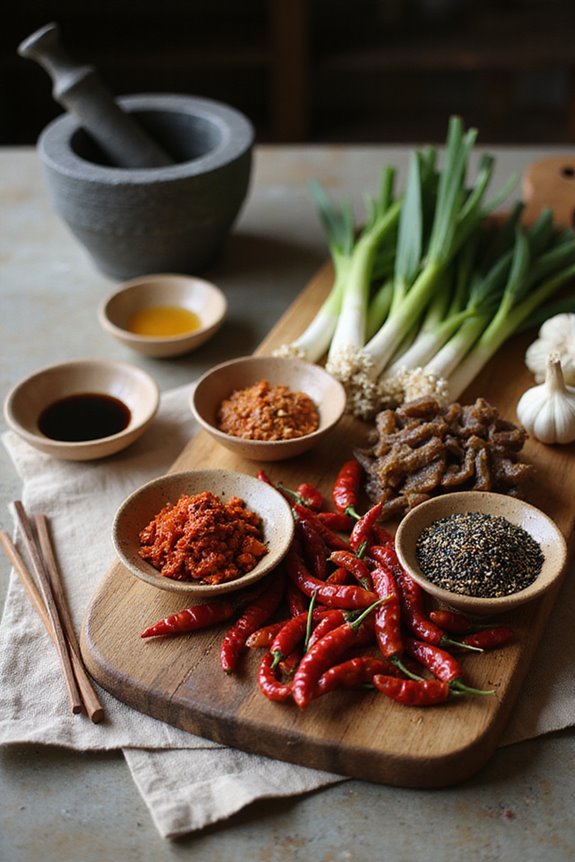
Korean cuisine is built upon a diverse array of ingredients that play crucial roles in the preparation of traditional dishes. Fermented vegetables, such as kimchi, are essential for flavor and nutrition, often used as side dishes or main components. Traditional broths are typically made using dried anchovies and seaweed, contributing savory depth to soups and stews. We often incorporate important fermented pastes, like gochujang and doenjang, to enhance the flavor profiles of our meals. Additionally, we utilize fresh vegetables, including garlic and green onions, which provide aromatic elements in many recipes. Finally, short-grain rice serves as a fundamental base for various meals, complementing the rich flavors of our dishes and honoring our culinary heritage. The use of traditional ingredients like fermented soybeans and red chili pepper is significant for achieving true Korean flavors.
Pantry Staples for Everyday Cooking
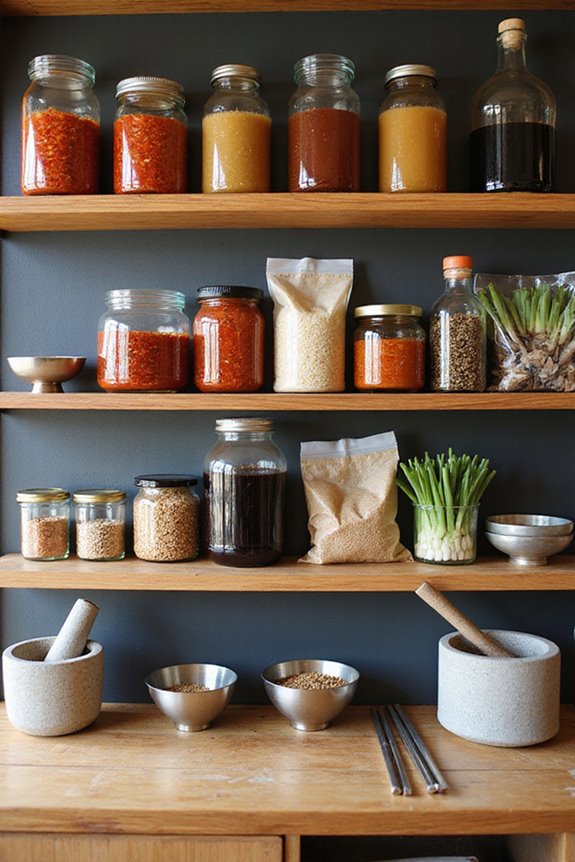
When we explore the essentials of Korean cooking, having a well-stocked pantry is critical for efficiency and flavor. Essential items like gochujang, doenjang, and soy sauce form the backbone of many Korean dishes, providing depth and umami. Rice wine vinegar adds a sweet-tangy note that enhances marinades and sauces. For oils, toasted sesame oil cultivates a distinct nutty flavor in various preparations, while MSG can elevate taste. Storage is key; using pantry organization tips can help keep these budget-friendly staples easily accessible. Incorporating short-grain rice, garlic, and Korean chili peppers into our pantry allows us to create a multitude of meals efficiently. These essentials enable us to embrace everyday cooking with confidence and ease. Additionally, consider using food safety standards to ensure the ingredients you select align with best practices for cooking and storage.
Cultural and Culinary Essential Items
Understanding the essential cultural and culinary items in Korean cooking allows us to enhance both our kitchen efficiency and our dining experience. Items like the ttukbaegi, an earthenware pot, exemplify the cultural significance of traditional cookware, preserving heat for stews and soups. The communal aspect of Korean dining is embodied in shared serving plates and braziers, which enhance interactions during meals. Chopsticks, often crafted from bamboo, are crucial for both eating and preparing ingredients, while essential utensils like spatulas and kitchen scissors streamline cooking tasks. By integrating these tools into our kitchens, we not only honor Korea’s culinary heritage but also create an environment that reflects the values of shared dining and well-prepared meals, enriching our culinary experiences. Additionally, using Korean barbecue tools enhances the authenticity of grilling, allowing for a more immersive experience in traditional Korean cuisine.
Unique Cooking Methods
Unique cooking methods play a pivotal role in crafting the rich flavors and textures characteristic of Korean dishes. Boiling techniques are essential for preparing soups and stews, such as *jjigae*, allowing ingredients to meld for a nourishing outcome. Meanwhile, grilling methods, particularly on charcoal grills, enhance the flavors of marinated meats like *bulgogi*, imparting a smoky aroma that is distinctive to Korean cuisine. Steaming is another common technique, especially for delicate ingredients, ensuring moisture retention and flavor while cooking. Each of these methods contributes considerably to the overall dining experience, providing layers of taste and texture that define traditional Korean dishes. Understanding these unique techniques enriches our appreciation for this vibrant culinary culture.
Traditional Korean Tableware
As we explore traditional Korean tableware, it’s important to recognize how this essential component of dining embodies both cultural significance and functionality. Bangjja, the traditional bronze tableware, holds historical importance as it was mainly used by royalty during the Goryeo and Joseon periods. Known for its durability and rich reddish-gold hue, Yugi craftsmanship symbolizes wealth and social status. Each piece, including bowls and chopsticks, contributes to a ceremonial dining experience, enhancing both aesthetics and tactile enjoyment. Additionally, the antimicrobial properties of Bangjja have regained attention for their health benefits, reflecting a blend of tradition and modern utility. By appreciating these unique aspects, we can truly understand the value of traditional Korean tableware in contemporary settings.
Must-Have Utensils for Serving
At the heart of a well-prepared Korean meal are the serving utensils that facilitate both functionality and shared dining experiences. Essential utensil types include spoons (sutgarak) for soup and rice, and chopsticks (jeotgarak) for side dishes and grilled meats. Tongs (gaji) are particularly valuable at Korean BBQ, allowing for easy serving. Small sharing spoons help transfer banchan from shared plates to individual bowls, promoting efficient sharing. Ladles (jaebi) are key for serving soups from large pots. Most of these utensils are crafted from metal, known for durability and heat retention, while modern kitchens might incorporate silicone or bamboo. When selecting utensils, consider both functionality and cultural significance to enhance your dining experience.
Essential Storage Solutions for Ingredients
When it comes to organizing our Korean kitchen effectively, choosing the right storage solutions is crucial for preserving ingredient quality and maximizing space. Efficient cabinet storage allows us to accommodate staple ingredients like gochujang and doenjang, utilizing soft-close hinges to protect delicate containers. By organizing our ingredients into dedicated compartments for easy access, we streamline our kitchen organization. Wall-mounted storage units optimize vertical space, enabling us to store small jars and hanging dried seaweed. Free-standing storage options, such as rolling carts, provide flexibility for bulk items and segregate fresh produce. Finally, refrigerating fermented pastes in airtight containers guarantees ingredient preservation while preventing odor transfer. Together, these strategies enhance both functionality and efficiency in our kitchens.
Frequently Asked Questions
What Is the History Behind Gochujang’s Development?
As the saying goes, “Good things come to those who wait”; gochujang’s rich history reflects centuries of fermentation techniques and regional variations, evolving from early fermented sauces to a beloved symbol of Korean culture.
How Do I Properly Store Kimchi for Freshness?
To keep our kimchi fresh, we’ll use airtight glass jars or BPA-free containers, while practicing fermentation techniques. We should monitor the brine and maintain cool temperatures in the fridge for ideal flavor and longevity.
What Are the Health Benefits of Traditional Korean Ingredients?
Sure, we could discuss the health benefits of traditional ingredients without mentioning kimchi—how original! Fermented foods like kimchi and doenjang enhance immunity and digestion, proving we don’t just take up space in our kitchens.
Can I Substitute Gochugaru With Other Chili Powders?
Absolutely, we can substitute gochugaru with various chili powder alternatives. While they might not perfectly replicate gochugaru’s unique flavor, options like crushed red pepper or smoked paprika can still enhance our dishes beautifully.
Are There Vegan Versions of Common Korean Sauces?
Have you ever wondered if vegan options exist for popular Korean sauces? Absolutely! We can easily find plant-based alternatives for gochujang, doenjang, and more, ensuring everyone can enjoy delicious flavors without compromising on dietary preferences.

